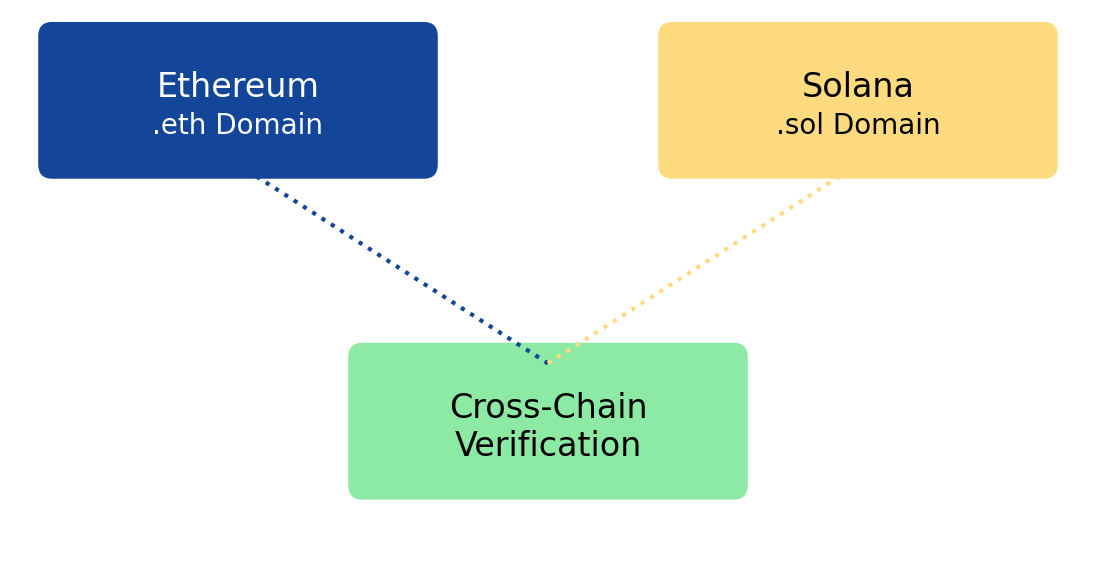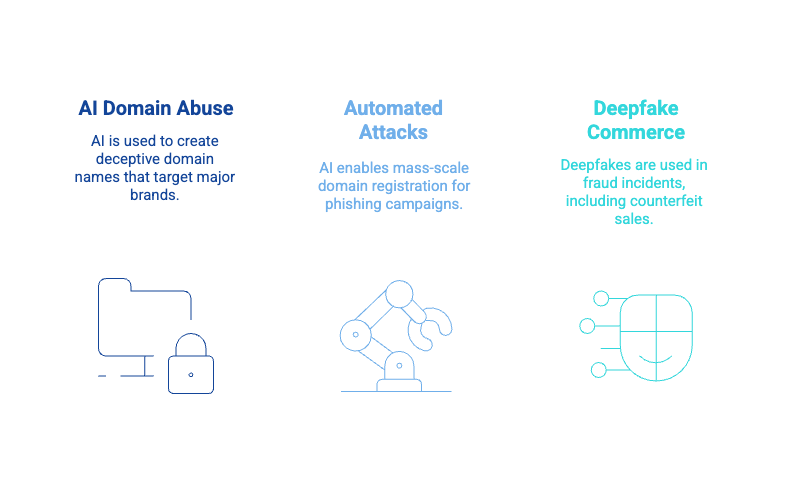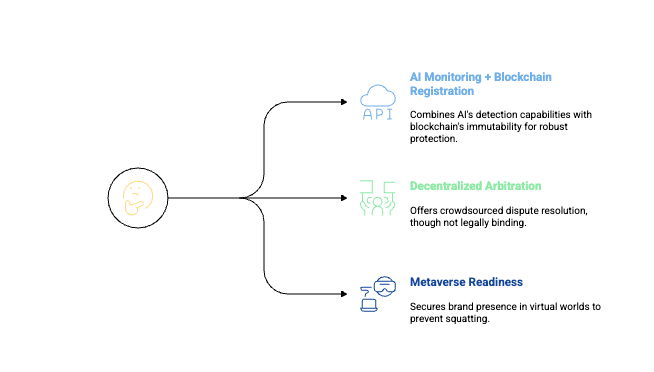Remember the days when protecting your brand online meant buying a .COM domain and maybe a .NET for good measure?
Fast forward to 2025, and the game has changed dramatically.
The digital landscape has exploded into a sprawling universe of 1,500+ top-level domains (TLDs), blockchain-powered Web3 addresses like .CRYPTO, and virtual storefronts in the metaverse.
Brands aren’t just fighting cybersquatters anymore; they’re racing to secure their identities across decentralized ecosystems, AI-generated copycats, and jurisdictional gray areas.
Protect Your Brand in 5 Steps! ✓ Check your brand's protection status now and identify gaps in your digital security.
Cybersquatting reached unprecedented levels recently, with WIPO reporting a 7% increase in cases for 2023, setting a new record.
The threat has evolved with artificial intelligence enabling rapid generation of deceptive domain variants, while blockchain domains present new challenges for traditional dispute resolution mechanisms.
According to EUIPO and cybersecurity experts, cross-border disputes have become increasingly common, with 42% of trademark applications now coming from non-EU companies, highlighting the global nature of the problem.
Hope comes in the form of AI-powered monitoring tools and blockchain-based systems that offer enhanced brand protection—though enterprise-level security comes with significant annual costs.
In this post, we’ll unpack the highs and lows of trademark domain protection in 2025.
From the rise of self-learning algorithms that predict infringement before it happens, to the eye-watering costs of defending your mark across hundreds of digital frontiers, we’ve got you covered.
The Bright Side: Cutting-Edge Tools Protecting Your Brand
Let’s start with the good news. In 2025, brands have access to weapons-grade tech to defend their trademarks—tools that would’ve sounded like sci-fi a decade ago.
From AI-powered sentries to blockchain’s unbreakable ledgers, here’s how innovation is tipping the scales in favor of brand owners.
AI: Your 24/7 Digital Bodyguard
Imagine having a tireless watchdog that scans every corner of the internet for trademark misuse.
That’s exactly what AI-powered monitoring tools like Huski.ai and Corsearch now offer. These systems use machine learning to:
-
Track 1,500+ TLDs, including quirky new ones like .AI (for artificial intelligence) and .shop.
-
Flag typosquatted domains (e.g., “Faceb00k.social”) and deepfake-powered phishing sites.
-
Predict high-risk zones using historical infringement data.
Major brands like Nike and Coca-Cola now deploy these tools across metaverse platforms and Web3 domains, with studies showing AI-powered monitoring reduces infringement response times by up to 40% compared to traditional methods.
Blockchain: No More “He Said, She Said” Disputes
Blockchain isn’t just for crypto bros anymore. Blockchain-based domain systems (e.g., .ETH, .CRYPTO) are revolutionizing ownership transparency. Here’s why:
-
Immutable records: Every registration is timestamped and unalterable, eliminating ownership disputes.
-
Smart contracts: Automate royalty payments or takedowns when infringement is detected.
-
Cross-chain verification: Platforms like Ethereum and Solana are integrating protocols to sync trademark registrations across blockchains.

According to recent blockchain research, these decentralized systems are showing promising results in reducing counterfeit activities through enhanced verification and tracking capabilities, while industry reports highlight how blockchain's transparent nature helps combat fraudulent listings.
Predictive Analytics: Stopping Squatters Before They Strike
Why wait for damage when you can prevent it? Tools like Clarivate’s predictive risk scoring analyze historical data to forecast where cybersquatters might strike next. For instance:
-
If your brand launches a product in Southeast Asia, the system flags high-risk TLDs like .VN (Vietnam) or .ID (Indonesia).
-
It identifies patterns in AI-generated domain variations, helping you defensively register them first.
AI vs. Traditional Monitoring: A Quick Comparison
| Feature | Modern AI Tools | Traditional Methods |
| Coverage | 1000+ TLDs including Web 3 domains | Limited to major TLDs (.com, .net, .org) |
| Response Time | Real-time monitoring alerts | Periodic manual reviews |
| Accuracy | Enhanced accuracy with reduced false positives | Higher false positive rates requiring manual verification |
| Cost Efficiency | Reduced operational costs through automation | Higher costs due to manual labor requirements |
The ROI of Modern Protection
Yes, these tools cost money—but the ROI is undeniable.
For SMEs: AI-powered automation streamlines evidence collection and dispute management, reducing legal expenses
For Enterprises: Advanced threat detection helps prevent costly cyber incidents and brand damage
According to recent industry analysis, companies implementing AI-driven brand protection see significant cost savings in legal and security operations
The Dark Side: Rising Costs and Smarter Threats
For all the progress in brand protection tech, 2025 isn’t all sunshine and rainbows.
The same innovations empowering brands are also arming bad actors—and the financial and legal hurdles are steeper than ever. Let’s break down the biggest headaches.
1. Skyrocketing Costs: Protecting Every Pixel
Gone are the days when securing a handful of domains (.COM, .NET, .ORG) was enough. In 2025, brands must defend their trademarks across:
-
1,500+ TLDs, including niche extensions like .AI, .SHOP, and .IO.
-
Web3 domains (e.g., .CRYPTO, .ETH) on blockchain registries like Ethereum and Solana.
-
Metaverse real estate, such as virtual storefronts in Decentraland or Sandbox.
The result? According to USPTO's 2025 budget report, trademark registration costs continue to rise.
The current fee structure, combined with necessary defensive registrations and monitoring services, creates significant financial pressure on businesses.
As per USPTO's Congressional Budget Submission, fees are adjusted to align with administrative costs, impacting both established companies and startups entering the market.
2. AI vs. AI: The Cybersquatting Arms Race
Here’s the irony: The same AI that protects brands is also weaponized against them.
Key Emerging Threats:
-
AI-Powered Domain Abuse: The UK’s National Cyber Security Centre reports an increase in AI-generated deceptive domain names targeting major brands.
-
Automated Attack Scale: DHS analysis shows AI enabling mass-scale domain registration for phishing campaigns.
-
Deepfake Commerce: Security.org reports a tenfold increase in deepfake-related fraud incidents between 2022 and 2023, including synthetic media used in counterfeit sales.

"The speed and scale of AI-enabled cyber threats are outpacing traditional detection methods" – UNODC Cyber Threat Report 2024
3. Jurisdictional Chaos: Who’s in Charge Here?
The rise of blockchain domains has fractured governance. While ICANN’s UDRP system handles traditional domains (e.g., .COM), blockchain-based ones (e.g., .CRYPTO) operate in decentralized ecosystems with no central authority. This means:
-
No universal takedown process: Resolving disputes on chains like Ethereum often requires manual arbitration.
-
Inconsistent laws: Countries like India still lack anti-cybersquatting laws, creating safe havens for infringers.
-
Cross-chain confusion: A trademark registered on Ethereum isn’t automatically recognized on Solana or Polkadot.
According to recent USPTO findings, brands face significant challenges in enforcing trademark rights on blockchain domains due to jurisdictional complexity and a lack of traditional enforcement mechanisms.
| Expense Category | Current Costs (2024) | Traditional Costs |
| Defensive Registrations | Significant investment required for comprehensive protection | Limited to basic domain registrations |
| Web3/Metaverse Coverage | Additional costs for emerging digital spaces | Not applicable |
| Legal Enforcement | Enhanced costs due to complex digital environments | Traditional legal proceedings |
| AI Monitoring Tools | Investment in automated protection systems | Manual review costs |
Legal Loopholes: Blockchain’s Double-Edged Sword
Blockchain’s “immutable” ownership records sound great—until a squatter grabs your brand’s .ETH domain. Because blockchain transactions can’t be reversed, brands must:
-
Pay ransom-like fees to buy back domains from squatters.
-
Rely on decentralized arbitration platforms like Kleros, which lack legal teeth.
-
Navigate vague “first-come, first-served” policies that favor squatters.
Future-Proofing Your Brand: Strategies for 2025 and Beyond
So, how do you navigate this chaotic landscape without going bankrupt or losing sleep?
The answer lies in hybrid strategies that blend tech innovation, legal savvy, and cost-conscious prioritization.
Let’s dive into actionable steps to future-proof your brand.
1. Adopt a “Hybrid Defense” Model
Combine AI’s speed with blockchain’s transparency to create a layered shield:
-
AI Monitoring + Blockchain Registration: Use tools like Corsearch to detect infringements, then register key trademarks on-chain for immutable proof of ownership.
-
Decentralized Arbitration: Platforms like Kleros offer crowdsourced dispute resolution for blockchain domains, though outcomes aren’t legally binding yet.
-
Metaverse Readiness: Reserve your brand’s name in virtual worlds like Decentraland now—before squatters do.

2. Lobby for (or Work Around) Regulatory Gaps
Push for unified policies while adapting to current flaws:
-
Support ICANN-Reform Initiatives: Advocate for ICANN’s updated UDRP rules to extend to blockchain domains.
-
Leverage the EU’s NIS2 Directive: This 2025 framework pressures member states to harmonize cyber laws, including domain abuse. Non-EU brands can use it as a blueprint.
-
Target High-Risk Jurisdictions: Prioritize enforcement in regions with weak laws (e.g., India) by partnering with local legal experts.
3. Cut Costs Without Compromising Security
You don’t need to defend every inch of the digital frontier. Focus on high-impact areas:
-
Prioritize TLDs by Risk: Use AI tools to identify which of the 1,500+ TLDs pose the greatest threat (e.g., .AI for tech firms, .PHARMA for healthcare).
-
Block, Don’t Buy: Services like Domain Protected Marks List (DPML) let you block your trademark across entire TLD categories for a flat fee.
-
Negotiate with Squatters: Sometimes, buying back a domain is cheaper than litigation. Use blockchain transaction histories to prove bad faith and haggle.
Reactive vs. Proactive Strategies: What Works in 2025?
| Tactic | Traditional Approach | Modern Approach |
| Monitoring | Manual periodic reviews after infringement | AI-powered predictive monitoring and real-time threat detection |
| Enforcement | Standard UDRP complaints and legal notices | Automated enforcement systems with smart contract integration |
| Strategy | Broad defensive registrations | Data-driven risk assessment and targeted protection |
| Effectiveness | Reactive with higher long-term costs | Proactive prevention with measurable ROI |
4. Prepare for the Next Wave: Predictive AI and Cross-Chain Verification
The future is already knocking:
-
Predictive AI: Tools like Huski.ai analyze global trademark filings, social trends, and even startup funding rounds to forecast where copycats might emerge.
-
Cross-Chain Trademark Sync: Projects like Polkadot’s interoperability protocol aim to unify blockchain domain records, so a .ETH registration automatically applies to .SOL (Solana).
-
AI-Generated Legal Drafts: Automate UDRP complaints and cease-and-desist letters using platforms like ChatGPT-5 (just have a lawyer review them!).
Survival of the Savviest
In 2025, trademark protection isn’t just about lawyers and paperwork—it’s a tech-driven battlefield. Brands that thrive will be those that:
-
Embrace AI to stay ahead of algorithmic squatters.
-
Master Blockchain to lock down ownership in decentralized spaces.
-
Pick Their Battles strategically, rather than trying to “own the entire internet.”
Yes, the costs are higher. Yes, the rules are murkier.
But with the right mix of innovation and pragmatism, your brand can survive—and even dominate—in this fragmented digital era.
FAQs: Your 2025 Trademark Protection Cheat Sheet
How much does it cost to protect a trademark globally in 2025?
SMEs should budget $10,000–$30,000 annually for defensive registrations, AI monitoring, and legal fees. Global enterprises often spend $500,000+.
Are blockchain domains worth the investment?
Yes, but only if your audience uses Web3 platforms. Start with .eth (Ethereum) and .CRYPTO, which dominate 75% of blockchain domain traffic.
Can AI tools replace trademark lawyers?
Not yet. AI excels at detection and drafting, but human expertise is critical for enforcement and arbitration.
What’s the biggest legal gap in 2025?
Jurisdictional conflicts between ICANN’s policies and decentralized systems. Always register trademarks in both ecosystems.
How do I enforce rights in the metaverse?
Work with platforms like Decentraland to report infringements, and register virtual trademarks early (it’s cheaper than reclaiming them later)
